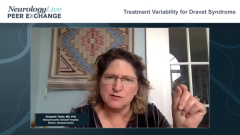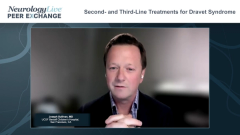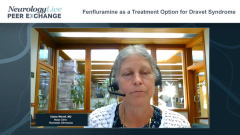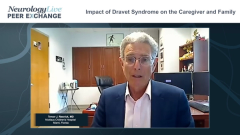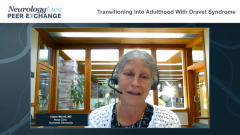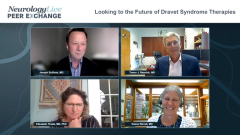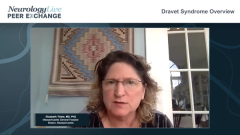
Cannabidiol as a Treatment Option for Dravet Syndrome
Elizabeth Thiele, MD, PhD, reviews cannabidiol oral solution as treatment of seizures associated with Dravet syndrome and the safety profile and dosing associated with it.
Episodes in this series

Joseph Sullivan, MD: If we think back to the first clinical trial that was done in the United States for Dravet syndrome using a purified formulation of pure cannabidiol [CBD]—it’s just a fascinating story of how social media and all the observations from this patient population happened because they were desperate, looking for other opportunities, and giving up on the long list of medications that we just discussed. Lo and behold, there was a company that already had a purified version of cannabidiol. For the purposes of this conversation, we’re speaking about that formulation and not many of the other artisanal derivations.
Elizabeth, you were a principal investigator in many of those trials. Could you walk us through a little of your experience and give your thoughts on the efficacy and adverse effects? With a lot of the medicines we use, we don’t fully understand the mechanism of action. That’s true for cannabidiol as well, but I know there have been some theories as to how that works. Let’s have an open CBD discussion here.
Elizabeth Thiele, MD, PhD: The past 8 years of me thinking about CBD in campus has probably been 1 of the most important aspects of my career. It’s an example where it does come from people commenting on positive responses to things instead of just the negatives. As I tell medical students and residents, we don’t practice medicine by anecdote, but listening and paying attention to anecdotes can be extremely helpful. This is a very good example. On social media there was a buzz once medical marijuana became available in Colorado and California. People wondered, “Is this effective?” You have the survey of a Dravet family saying, “Yes, it can be effective,” which is really what led to the development of this purified formulation of CBD.
Based on what I’ve learned from using this as a treatment for children with Dravet syndrome and other epilepsies over the past 8 years, it can be effective. It’s not a silver bullet for epilepsy, as many people in the press and elsewhere would have led us to believe for not only epilepsy but for many ailments. But clearly, it’s an important addition to our toolbox of treatments for children with Dravet syndrome, LGS [Lennox-Gastaut syndrome], TSC [tuberous sclerosis complex], and likely other epilepsies.
CBD is a really interesting chemical. It’s important to know that it doesn’t have any psychoactive properties like THC [tetrahydrocannabinol]. There’s a lot of work being done to figure out the mechanisms of action. The best thought now is it’s GPR55, a G-binding protein that regulates neuronal excitability as well as modulation of the TRPV1 ion channels. It may also modulate adenosine. Like many of our medications, there are several mechanisms of action in the treatment of epilepsy. Importantly, it doesn’t seem to work via the endocannabinoid system. The first thought was, “Here’s a phytocannabinoid. Does it interact with the endocannabinoids?” Knowing that’s not true is important. It will be important to try to delineate the mechanisms as well as the efficacy in other epilepsies and disorders.
One of the things I’ve been most impressed with is the safety tolerability profile. When I discuss treatment options with my Dravet families, and we talk about CBD compared with the other medications, safety-wise, other than the drug interactions that have been pretty well characterized—particularly with clobazam and valproate—it’s very well tolerated. One of the main adverse effects is loose stool or diarrhea. Many of my Dravet families and other families view that as a positive adverse effect, because many of these kids have such significant constipation and elaborate bowel regimens that they’re able to back down on those.
It has an important role to consider as a treatment option in the management of children with Dravet. We’re going to talk about the other options. We don’t have any data suggesting 1 is better than the other. In reality, I already have a lot of my patients on both, and that will be how we manage Dravet syndrome. Even if I get a 50% or 60% reduction in seizures with 1 treatment option, I’m not at my ideal goal, so I would try the other options.
Joseph Sullivan, MD: I agree. I always say this in the talks I give to residents. Why does the brain follow mathematics? You start out with 10 seizures, you get a 50% reduction. Now you’re on 5 seizures and you get another 50% reduction. Our goal is to try to get as much reduction as possible. Could you make a few more comments on dosing? You were involved with the TSC studies and the higher doses that were different from the Dravet study. Do you have any thoughts on what your starting dose is for cannabidiol and what the sweet spot has been? Maybe I’ll ask others to comment as well.
Elizabeth Thiele, MD, PhD: I agree with the FDA labeling of starting at 5 mg/kg per day and then titrating up. I pretty much follow those. In the TSC trial, as well as an expanded-access program, we did use higher dosing. We learned from all the trials that CBD, like many of our medications, has a broad dose range. That’s a good thing to know. Many people respond very well to the lower doses. Sometimes response is even better at the lower doses than the higher doses.
In the TSC trial, we learned that even though going to 50 mg/kg per day didn’t have the dose response with regard to efficacy, there was safe passage. Even though there were more adverse events at the higher doses, as expected, it was still pretty well-tolerated. Some patients do better and need the higher dose. Through the different dose ranges of the different trials, we learned a lot, but I believe I achieve efficacy with most of my patients within the recommended dosing.
Joseph Sullivan, MD: Any comments, Elaine and Trevor? Do you agree or disagree?
Elaine Wirrell, MD: I agree. I typically work them up to about 10 mg/kg per day, and then I assess if we need to go higher. Many patients get better efficacy as we go higher, but tolerability seems to be a little better at lower doses, so that’s typically where I start.
Trevor J. Resnick, MD: Ditto for everything that Elizabeth said. One thing I’ve found in a few patients is if the response improves or continues to improve as you go to higher doses, then it’s worthwhile continuing to increase. But if you hit a plateau, I’d say the vast majority of my patients get their response somewhere between 10 and 20 mg/kg. It’s the minority that you have to go up, where going up higher actually helps.
Joseph Sullivan, MD: I was going to close with that because it’s nice to have the safe passage. When you look at a study of 120 patients, there may be 5 who did do better at the higher dose. But when you look at a group analysis, it doesn’t shut out. The bars look the same. But if you have 1 patient who’s sitting in front of you and they’re having a dose-related response and improvement, then we know that 50 mg/kg has been tolerated. You certainly can go in that direction if necessary.
Thank you for watching this Neurology Live® Peer Exchange. If you enjoyed the content, please subscribe to our e-newsletters to receive upcoming Peer Exchanges and other great content right in your in-box.
Transcript Edited for Clarity
Newsletter
Keep your finger on the pulse of neurology—subscribe to NeurologyLive for expert interviews, new data, and breakthrough treatment updates.


